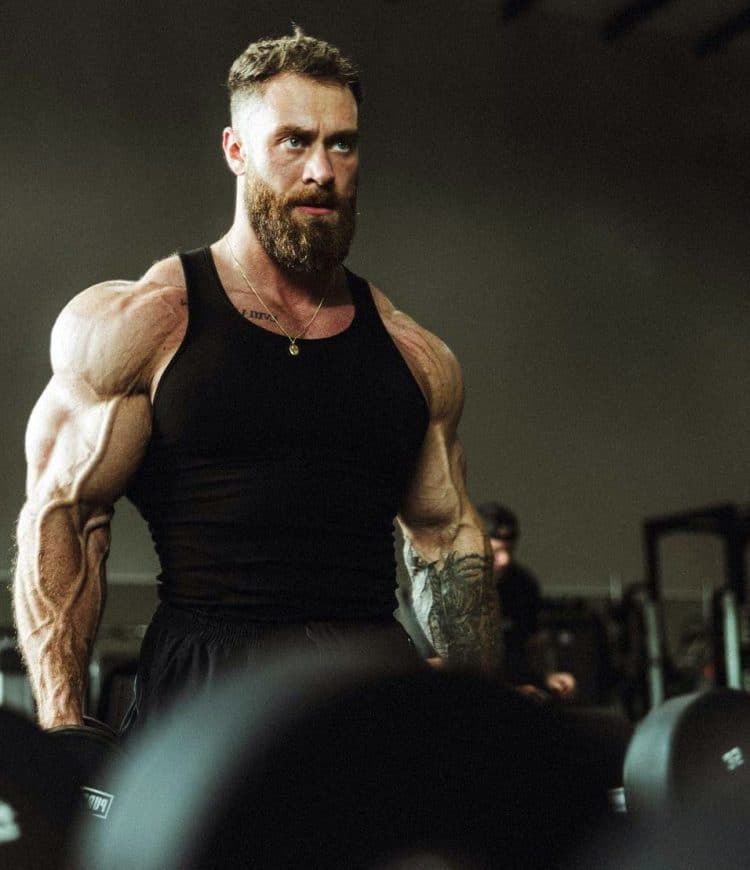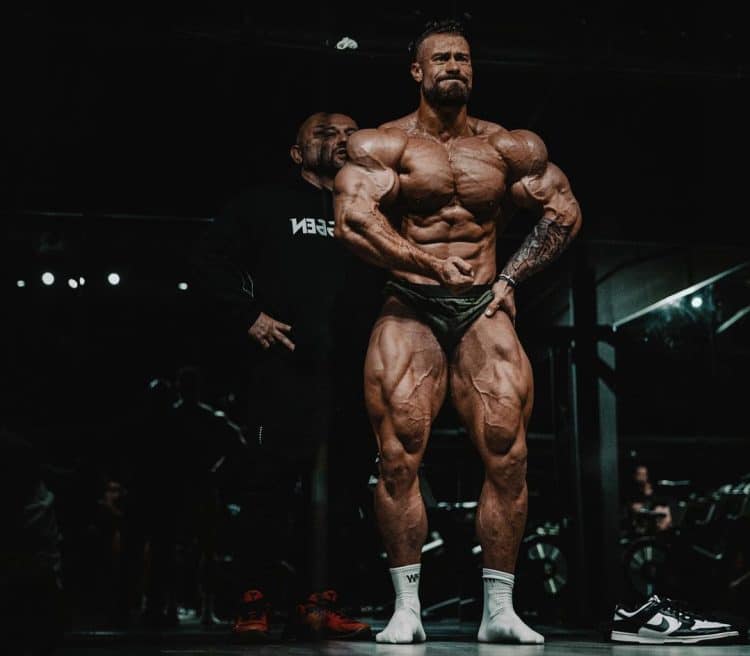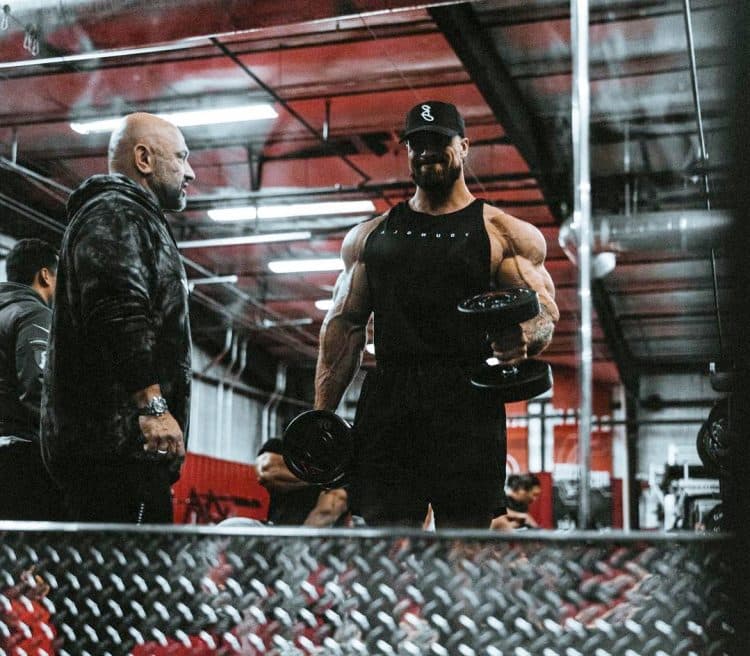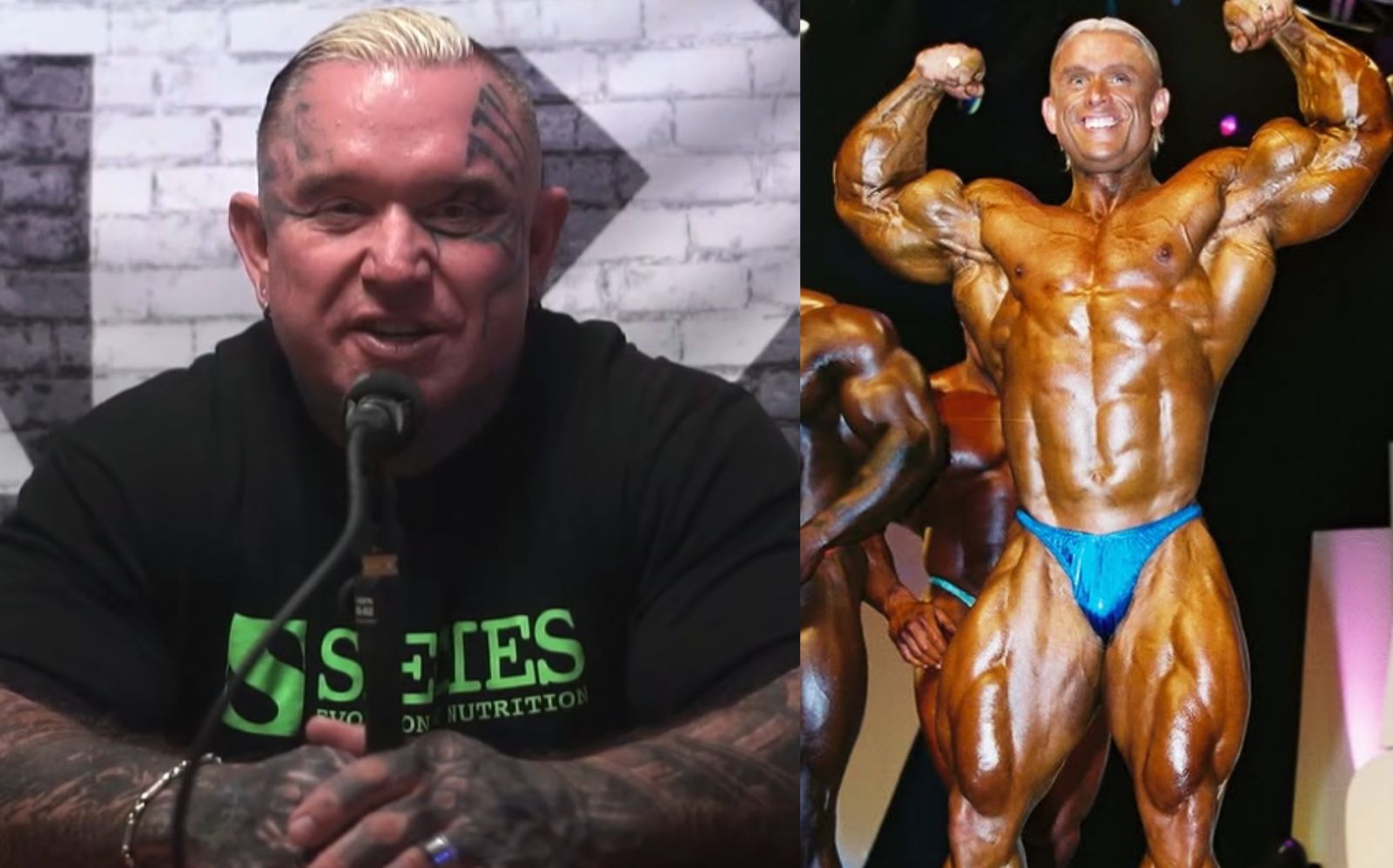Chris Bumstead is arguably the most popular bodybuilder of the 2010-2020s era. What’s even more impressive is that he is not even from the more popular Men’s Open division. Instead, Bumstead competes in the Classic Physique division, which was introduced in 2016.
While the Men’s Open division was being criticized for sacrificing aesthetics in favor of size, Bumstead dazzled the world with his incredible physique aesthetics.
As a personal trainer, I’m often approached by natty athletes who want to know if they can build a physique like Bumstead’s. Although most expect a yes or no response, the reality is far more nuanced.
Most professional bodybuilders are enhanced athletes, meaning they use performance-enhancing drugs (PEDs) to achieve their maximum physical potential. Plus, several factors, including genetics, age, training experience, and objectives, can influence progress.
Understanding Chris Bumstead’s Training Philosophy

Training like Bumstead goes beyond copying the exercises he performs. To look like a champion, you must think like them and understand why they do what they do. The great thing about Bumstead is that he is very transparent about his training methodologies and relies on science-backed principles to improve his physique.
An Overview of His Training Split
Bumstead trains each muscle twice weekly in the off-season. While one session is the main workout, the other is mainly to stimulate the target muscles to maximize adaptations. This approach aligns with the findings of a study that suggests greater training volume over the week can be more effective in enhancing hypertrophy over an eight-week period. (1)
Level Up Your Fitness: Join our 💪 strong community in Fitness Volt Newsletter. Get daily inspiration, expert-backed workouts, nutrition tips, the latest in strength sports, and the support you need to reach your goals. Subscribe for free!
Bumstead’s Training Principles To Maximize Hypertrophy
Inculcate the following exercise principles into your routine for optimal muscle-building results:
Full Range of Motion
Bumstead is big on following a full range of motion (ROM) training. Not only does it help maximize muscle fiber stimulation, but it also improves mobility. This can help enhance training performance and overall functionality.
Focus on the Eccentrics
There is scientific evidence to suggest that the lowering phase of an exercise might be more anabolic than the lifting phase (2). Slowing down the eccentrics increases the time under tension, which can boost hypertrophy (3). Bumstead aims for a three to five-second lowering phase to get the best bang for his buck.
Prioritize Mind-Muscle Connection
Building muscles isn’t just about moving weight from Point A to Point B. You must control the weight and focus on contracting the target muscles throughout the ROM. Beginner natties struggling to forge a strong mind-muscle connection should try using a slower rep tempo (3-1-1-1) and lightening the load.
Progressive Overload
This is the cornerstone of any successful muscle-building program. You can incorporate progressive overload into your routine by gradually increasing the weight, sets, and reps, employing advanced training techniques, or limiting rest time between sets.
Chris Bumstead’s Training Plan: A Sample Week For Natties

Before we get into how beginners can adapt Bumstead’s exercise programming for the best results, let’s explore how the Classic Physique Olympia champ actually trains.
Pro bodybuilders usually change their training regime according to the time of the year and their competition schedule. In this article, we’ll stick to Bumstead’s off-season training routine, as it will be the most appropriate for beginners.
With that out of the way, here is an overview of Bumstead’s unconventional eight-day off-season training split:
| Day | Muscle Groups |
| Day 1 | Quads and Calves |
| Day 2 | Chest (Plus Some Triceps) |
| Day 3 | Back (Thickness) (Plus Some Bis) |
| Day 4 | Rest |
| Day 5 | Shoulders (Plus Some Chest) |
| Day 6 | Hamstrings and Back (Width) |
| Day 7 | Arms |
| Day 8 | Rest |
Day One: Quads and Calves
| Exercise | Sets | Reps | |
| Leg Extension (Drop Set) | 2 | 10, 10 | |
| Smith Machine Squat | 2 | 6-10 | |
| Tri-Set | Unilateral Leg Press | 3 | 8-10 |
| Sissy Squat | 3 | 8-10 | |
| Seated Calf Raise | 3 | 8-10 |
Day Two: Chest (Plus Some Triceps)
| Exercise | Sets | Reps |
| Incline Dumbbell Press | 2 | 8-10 |
| Incline Dumbbell Fly | 2 | 8-10 |
| Hammer Strength Machine Incline Press (Drop Set) | 2 | 6-10 |
| Pec Deck Flye | 3 | 15 |
| EZ Bar Skull Crushers | 2 | 8-10 |
| Push-ups | 2 | Failure |
Day Three: Back (Thickness) (Plus Some Bis)
| Exercise | Sets | Reps |
| Close-Grip Underhand Lat Pulldown | 3 | 10-12 |
| Chest-Supported Dumbbell Row | 2 | 8-10 |
| Chest Supported T-Bar Row (Drop Set) | 2 | 8-10 |
| Machine Chest Supported Row | 2 | 10-12 |
| Cable Lat Extension | 2 | 10-12 |
| Machine Preacher Curl | 2 | 10-12 |
Day Five: Shoulders (Plus Some Chest)
| Exercise | Sets | Reps | |
| Seated Dumbbell Shoulder Press | 2 | 6-10 | |
| Machine Shoulder Press (Drop Set) | 3 | 6-10 | |
| Seated Dumbbell Lateral Raise (Drop Set) | 2 | 8-10 | |
| Machine Lateral Raise | 2 | 10-12 | |
| Superset | Reverse Pec Deck Flye | 2 | 10-12 |
| Machine Flye | 2 | 10-12 |
Day Six: Hamstrings and Back (Width)
| Exercise | Sets | Reps |
| Lying Leg Curl | 2 | 8-10 |
| Deadlift | 2 | 4-8 |
| Seated Leg Curl | 2 | 8-10 |
| Standing Leg Curl | 2 | 8-10 |
| Wide-Grip Lat Pulldowns | 3 | 8-10 |
| Cable Lat Extension | 2 | 10-12 |
Day Seven: Arms
| Exercise | Sets | Reps |
| Rope Cable Triceps Pressdown (Drop Set) | 2 | 8-10 |
| Incline Dumbbell Skull Crusher: | 2 | 8-10 |
| EZ Bar Preacher Curl (Drop Set) | 3 | 8-10 |
| Dumbbell Curl | 2 | 10-12 |
| Cable Cross Body Triceps | 2 | 10-15 |
| Low Pulley Cable Curl With V-Bar Handle (Drop Set) | 2 | 10-12 |
Day Four & Eight: Rest
Bumstead typically follows a three-days-on, one-day-off split in the off-season. The off-day allows his muscles ample time to relax and recover so he can push harder in the upcoming workouts.
Adapting the Routine for a Beginner (Natty Considerations)
Chris Bumstead / InstagramBumstead has several things working for him. He has the genetics, drive, discipline, the best PEDs, and the right set of people around him.
As a natty lifter, you are playing a different game with a different set of rules, so you must adapt your routine accordingly. Here is how to do it:
Decoding Optimal Volume, Intensity, and Frequency
When all is said and done, your training output will dictate your results. As a natty lifter, you must get comfortable training close to mechanical failure (one to three reps in reserve) to maximize muscle fiber recruitment and growth.
The optimal training volume, intensity, and frequency for you will depend on your current fitness levels and training objectives.
Experts recommend starting small, building a foundation, and then gradually increasing the training volume to ensure consistent progress. Going too hard too soon significantly increases injury risk, which can set you back.
Level Up Your Fitness: Join our 💪 strong community in Fitness Volt Newsletter. Get daily inspiration, expert-backed workouts, nutrition tips, the latest in strength sports, and the support you need to reach your goals. Subscribe for free!
Bumstead’s training routine typically has moderate to high volume. However, you must adjust it according to your unique needs.
Research suggests that performing eight to 12 repetitions per set with a load of 60–80% of one repetition maximum (1RM) is the most efficient way to maximize muscle hypertrophy. (4)
Keep It Simple & Getting the Basics Right
Although Bumstead has access to the most advanced equipment, he keeps his workouts rather straightforward and focuses on functional compound movements. There is no reason why a natty should do otherwise.
Furthermore, you must focus on your entire workout flow. Spend five to 10 minutes performing dynamic stretches to warm up before each workout to prime your joints, tendons, ligaments, connective tissues, and muscles.
Similarly, a five to 10-minute cool-down routine comprising static stretches can help flush the metabolites out of your muscles and boost recovery.
Recovery (Nutrition and Supplement Consideration)

As you can probably tell, Bumstead employs several intensifiers in his routine to maximize target muscle stimulation and growth. This can lead to greater micro tears in the muscle fibers.
Bumstead doesn’t pretend to be a natty.
One of the biggest benefits of using gear is that it speeds up post-workout recovery. It helps repair and rebuild muscle tissues and reduces recovery time between workouts. This can boost your overall training volume and stimulation, resulting in greater gains.
Remember, you break down muscle tissue when you train. Your muscles grow bigger and stronger when you supply them with ample building material during the recovery phase.
As a natural bodybuilder, you must prioritize your recovery via a personalized nutrition protocol. Determine a suitable TDEE goal and macronutrient split as per your goals. Nutrition scientist Dr. Layne Norton recommends aiming for 1.6-2.2 grams of protein per kilogram of body weight per day for optimal muscle protein synthesis.
While sports nutrition supplements aren’t as potent as anabolic steroids, they can play a vital role in speeding up recovery and muscle growth. Beginners can opt for a creatine and whey protein supplement to support their recovery and ensure they are hitting their daily macronutrient goals.
Exercise Order
The sequence of the exercises in your workouts plays a more important role than most people realize.
Dr. Mike Israerel, Ph.D. in Sport Physiology, recommends natty beginners focus on compound movements and drilling the movement mechanics. Isolation exercises can be saved for the end of the workout once fatigue starts to set in and your form on multi-joint lifts starts to break.
Advanced natty lifters, on the other hand, can vary the exercise order depending on the net session stimulus-to-fatigue ratio. The goal here will be to pick the exercises that will give you the most muscle activation without taxing your central nervous system (CNS) too much.
For instance, you might want to opt for the seated cable rows instead of barbell bent-over rows, as they both bias the lats, but the latter can cause significantly more systematic fatigue.
Exercises that cause more fatigue typically necessitate longer recovery periods, which can impact your training performance throughout the week.
Conclusion
Building an Olympia-caliber physique without PEDs is a tall order. For instance, allegedly, no top 10 bodybuilder in any IFBB men’s division (Open, 212, Classic Physique, and Men’s Physique) is a natty.
While a natty could strive to build a physique like Bumstead’s, aiming to beat him at his own game can be considered overly ambitious. Nonetheless, that shouldn’t stop you from chasing your dream physique and maximizing your genetic potential.
Bumstead’s Olympia-winning physique is the result of years of hard work and unwavering discipline. Staying consistent and patient and following a personalized training program will help maximize the returns and longevity while limiting injury risk.
If you have any questions about Chris Bumstead’s training routine, drop them in the comments below, and I’ll be happy to help!
References:
- Krzysztofik M, Wilk M, Wojdała G, Gołaś A. Maximizing Muscle Hypertrophy: A Systematic Review of Advanced Resistance Training Techniques and Methods. Int J Environ Res Public Health. 2019;16(24):4897. Published 2019 Dec 4. doi:10.3390/ijerph16244897
- Schoenfeld, B. J., Ogborn, D. I., Vigotsky, A. D., Franchi, M. V., & Krieger, J. W. (2017). Hypertrophic Effects of Concentric vs. Eccentric Muscle Actions: A Systematic Review and Meta-analysis. Journal of strength and conditioning research, 31(9), 2599–2608. https://doi.org/10.1519/JSC.0000000000001983
- Burd NA, Andrews RJ, West DW, et al. Muscle time under tension during resistance exercise stimulates differential muscle protein sub-fractional synthetic responses in men. J Physiol. 2012;590(2):351-362. doi:10.1113/jphysiol.2011.221200
- Schoenfeld BJ, Grgic J, Van Every DW, Plotkin DL. Loading Recommendations for Muscle Strength, Hypertrophy, and Local Endurance: A Re-Examination of the Repetition Continuum. Sports (Basel). 2021;9(2):32. Published 2021 Feb 22. doi:10.3390/sports9020032









